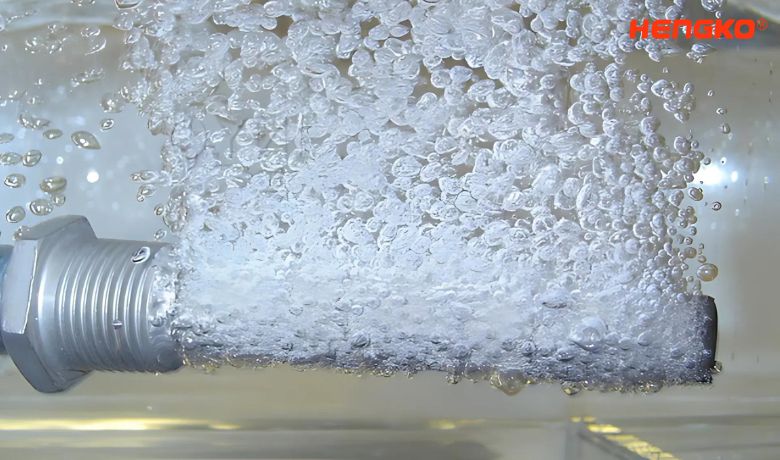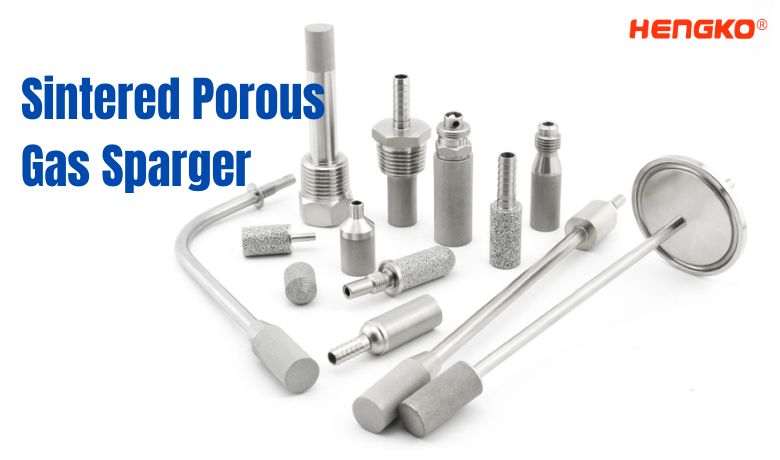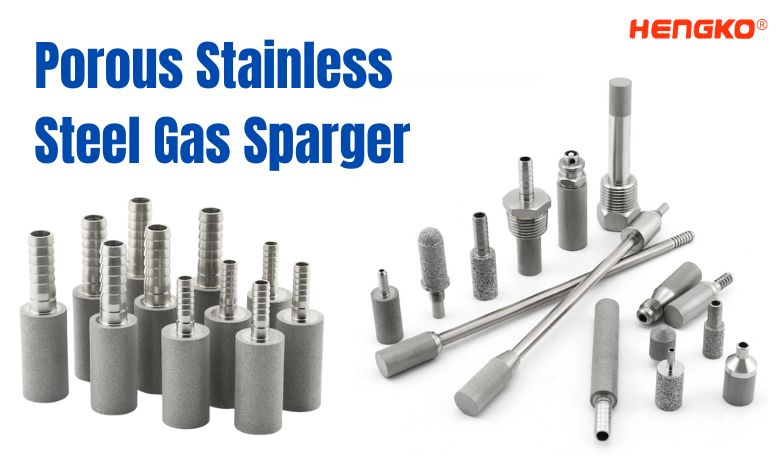Porous Metal Spargers: A Comprehensive Guide to Selection and Installation
1.Porous Metal Spargers: A Brief Introduction
Porous metal spargers are specialized devices constructed from a porous metal material.
They are designed to distribute gases or liquids into a liquid or gas phase in a controlled manner.
This distribution process is often referred to as "sparging."
Sparging is a critical operation in many industrial processes, serving a variety of purposes:
◆ Mass transfer: Promoting the transfer of a component between two phases.
◆ Mixing: Ensuring thorough blending of different substances.
◆ Aeration: Introducing oxygen or other gases into a liquid.
◆ Reaction enhancement: Providing intimate contact between reactants.
◆ Cleaning and purification: Removing contaminants or impurities.
Common applications of porous metal spargers include:
◆ Chemical engineering: For processes like aeration, mixing, and gas-liquid reactions.
◆ Environmental remediation: To treat contaminated water or soil through aeration or injection of chemicals.
◆ Food and beverage industry: For carbonation, oxygenation, and sterilization.
◆Pharmaceutical manufacturing: In processes like fermentation and filtration.
◆ Wastewater treatment: For biological treatment and aeration.
The unique properties of porous metal spargers, such as their large surface area, uniform pore size distribution,
and durability, make them ideal for these and other industrial applications.
2.Understanding Porous Metal Spargers
Definition and Key Characteristics
A porous metal sparger is a device fabricated from a porous metal material, typically sintered metal or expanded metal.
It features a network of interconnected pores that allow for the controlled distribution of gases or liquids.
Key characteristics of porous metal spargers include:
◆Porosity: The percentage of void space within the metal structure.
◆Pore size distribution: The range of pore sizes, which affects the distribution of the sparged fluid.
◆Permeability: The ability of the material to allow fluid flow through its pores.
◆Wettability: The degree to which the metal surface interacts with the sparged fluid.
◆Mechanical strength: The ability to withstand pressure and other mechanical stresses.
◆Corrosion resistance: The ability to resist degradation in specific environments.
Comparison with Traditional Sparging Methods
Porous metal spargers offer several advantages over traditional sparging methods:
◆Uniform distribution: They provide a more even and consistent distribution of the sparged fluid compared to methods like simple pipes or nozzles.
◆Increased efficiency: The large surface area of porous metal spargers promotes efficient mass transfer and mixing.
◆Reduced fouling: The fine pore size distribution can help to minimize fouling and clogging.
◆Versatility: They can be used in a wide range of applications and environments.
◆Durability: Porous metal spargers are generally durable and long-lasting.
While porous metal spargers offer many benefits, they may not be suitable for all applications. Factors such as the specific process requirements, fluid properties, and operating conditions should be carefully considered when selecting a sparging method.
3. Benefits of Using Porous Metal Spargers
Enhanced Gas Transfer Efficiency
One of the primary advantages of porous metal spargers is their superior gas transfer efficiency. The large surface area provided by the interconnected pores allows for intimate contact between the gas and liquid phases, promoting rapid mass transfer. This is particularly beneficial in applications where efficient gas-liquid exchange is critical, such as aeration, absorption, and stripping processes.
Improved Mixing and Aeration
Porous metal spargers also excel at mixing and aeration. The fine-scale distribution of gas bubbles generated by the sparger creates turbulence and promotes thorough mixing of the liquid. This is essential for processes like fermentation, wastewater treatment, and chemical reactions that require intimate contact between reactants. Additionally, the efficient aeration provided by porous metal spargers can enhance the growth of aerobic microorganisms and improve the overall performance of biological processes.
Durability and Longevity in Harsh Environments
Porous metal spargers are known for their durability and longevity. They are typically constructed from corrosion-resistant materials, such as sintered stainless steel or titanium, making them suitable for use in harsh environments. The porous metal structure is also mechanically robust, capable of withstanding pressure fluctuations and other stresses. This durability ensures reliable performance and a long service life, even in demanding applications.

4. Selection Points for Porous Metal Spargers You Should Check
When choosing a porous metal sparger, several factors must be considered to ensure optimal performance and suitability for the specific application.
Material Considerations
The choice of material for the porous metal sparger depends on the properties of the sparged fluid, the operating environment, and the desired level of corrosion resistance. Common materials include:
◆Stainless steel: Offers good corrosion resistance and mechanical strength, making it suitable for many applications.
◆Hastelloy: A nickel-based alloy with excellent resistance to acids, alkalis, and oxidizing agents, making it ideal for corrosive environments.
◆Titanium: Provides excellent corrosion resistance, even in seawater and other aggressive environments.
Pore Size and Distribution
The pore size and distribution of the porous metal sparger influence the gas or liquid distribution, the pressure drop, and the degree of mixing. Smaller pore sizes can provide finer gas dispersion but may increase the pressure drop. Conversely, larger pore sizes can reduce the pressure drop but may result in coarser gas dispersion. The appropriate pore size and distribution depend on the specific application requirements.
Flow Rate Requirements
The flow rate of the sparged fluid is a critical factor in selecting a porous metal sparger. The sparger must be able to handle the desired flow rate without excessive pressure drop or clogging. The flow rate can also influence the choice of sparger design and the arrangement of multiple spargers.
Application-Specific Needs
The specific application will dictate additional selection criteria. For example:
◆Liquids: The viscosity, surface tension, and chemical properties of the liquid will influence the choice of sparger material and design.
◆Gases: The gas density, flow rate, and solubility in the liquid will affect the sparger's performance.
◆Mixing: The desired degree of mixing will influence the pore size distribution and the arrangement of spargers.
◆Aeration: The required oxygen transfer rate will determine the sparger's size and design.
By carefully considering these factors, it is possible to select a porous metal sparger that meets the specific needs of the application and provides optimal performance.
5. Installation Guidelines
Pre-Installation Checks
Before installing a porous metal sparger, ensure the following:
◆Compatibility: Verify that the sparger material is compatible with the sparged fluid and the operating environment.
◆Flow rate: Ensure that the sparger is capable of handling the desired flow rate.
◆Pressure: Check that the system pressure is within the sparger's operating limits.
◆Piping and fittings: Ensure that the piping and fittings are clean and free of debris.
Step-by-Step Installation Process
1. Prepare the system: Clean and flush the piping and vessel to remove any contaminants.
2.Place and orient the sparger: Position the sparger in the desired location, ensuring proper orientation and alignment with the piping.
3.Secure the sparger: Use appropriate clamps, brackets, or other methods to securely fasten the sparger in place.
4.Connect the piping: Connect the inlet and outlet piping to the sparger, ensuring tight connections and proper sealing.
5.Perform a pressure test: Conduct a pressure test to verify the integrity of the installation and detect any leaks.
Common Installation Mistakes to Avoid
◆Incorrect orientation: Ensure that the sparger is oriented correctly to achieve the desired flow pattern and distribution.
◆Inadequate support: Provide sufficient support to prevent the sparger from sagging or vibrating.
◆Improper sealing: Ensure that all connections are properly sealed to prevent leaks and contamination.
◆Clogging: Avoid clogging by ensuring that the sparger is installed in a location with minimal particulate matter.
◆Overpressure: Avoid exceeding the sparger's pressure rating to prevent damage.
By following these guidelines, you can ensure a successful and safe installation of your porous metal sparger, leading to optimal performance and long-term durability.

6. Maintenance and Troubleshooting
Regular Maintenance Practices
To ensure the longevity and optimal performance of a porous metal sparger, regular maintenance is essential. This includes:
◆Visual inspections: Periodically inspect the sparger for signs of corrosion, fouling, or damage.
◆Pressure drop checks: Monitor the pressure drop across the sparger to detect any clogging or changes in performance.
◆Cleaning: Clean the sparger regularly to remove accumulated deposits and maintain its efficiency.
◆Calibration: If applicable, calibrate the sparger to ensure accurate flow measurements or gas delivery.
Identifying and Resolving Common Issues
◆Clogging: If the pressure drop across the sparger increases significantly, it may indicate clogging. Clean the sparger using appropriate methods, such as backwashing or soaking in a cleaning solution.
◆Fouling: Fouling can occur due to the accumulation of deposits on the sparger's surface. Regular cleaning and the use of anti-fouling agents can help prevent fouling.
◆Corrosion: Corrosion can weaken the sparger and reduce its lifespan. Choose a corrosion-resistant material and inspect the sparger regularly for signs of corrosion.
◆Leaks: Leaks can cause inefficiencies and safety hazards. Inspect the connections and seals regularly and tighten or replace them as needed.
Tips for Cleaning and Maintaining Spargers
◆Cleaning frequency: The frequency of cleaning depends on the specific application and the nature of the sparged fluid. Regular cleaning is generally recommended, especially in environments with high levels of contaminants.
◆Cleaning methods: Common cleaning methods include backwashing, soaking in cleaning solutions, or mechanical cleaning. The appropriate method depends on the type of fouling or deposits.
◆Anti-fouling agents: The use of anti-fouling agents can help reduce the frequency of cleaning and improve sparger performance.
◆Specialized cleaning services: For complex or heavily fouled spargers, consider consulting specialized cleaning services.
By following these maintenance practices and addressing common issues promptly, you can ensure the long-term reliability and performance of your porous metal sparger.
Conclusion
As above information, You will know Porous metal spargers offer many benefits, but proper selection, installation, and maintenance are crucial.
Consult experts for complex applications to ensure optimal performance.
If you're looking for expert guidance on selecting or installing the perfect porous metal sparger for your system,
or if you have specific requirements for customized sparger elements, HENGKO is here to help.
We specialize in OEM manufacturing of porous sintered metal sparger elements tailored to your unique industrial needs.
For consultation or to discuss your custom project, feel free to contact us at ka@hengko.com.
Our team is ready to assist you in optimizing your sparging solutions.
If you are also find some special or like to Customize Porous Metal Spargers, Contact HENGKO now by
email today ka@hengko.com
Send your message to us:
